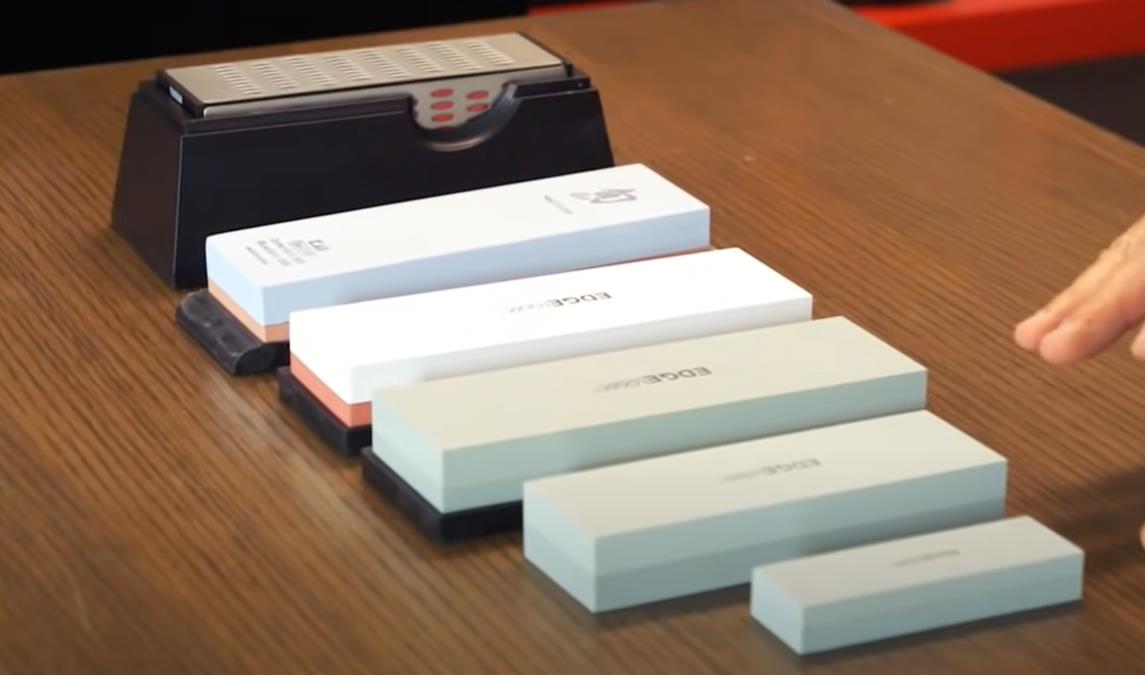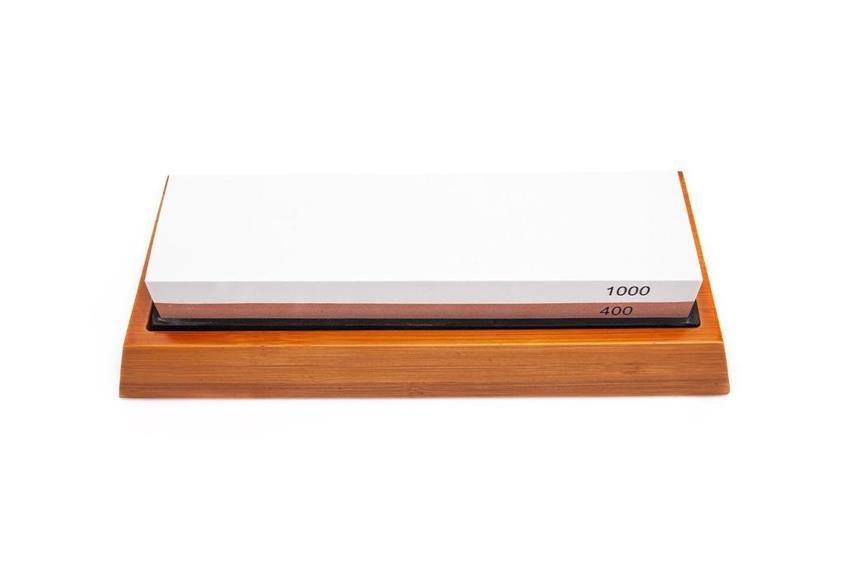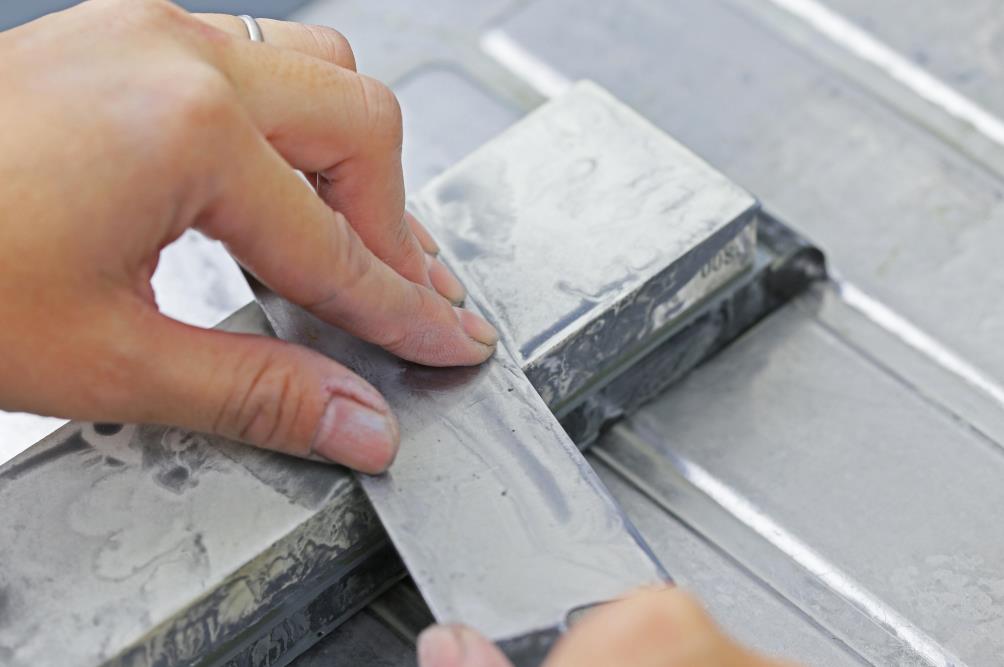A dull knife blade calls for a sharpening stone eventually. Though honing rods can help knives become sharper, they don’t work the same as sharpening stones.
One knife sharpening device that both professionals and home cooks prefer is whetstones. This tool to sharpen knives removes material from the blade’s edge. Once all the pushing and pulling is over, the knife gets a brand new cutting edge as sharp as the first day, if not sharper.
While they are excellent remedies to bring back the sharpness of a knife, they come in varieties. Some whetstones are better at sharpening certain knives than others. In this article, we’ll go over sharpening stones in an in-depth coverage, look at the different grits and materials, and answer commonly asked questions.
Table of contents
Sharpening stone vs. whetstone vs. water stone
There is some terminology that goes into this. While whetstones may sound like “wet stones,” all whetstones are sharpening stones. Whet means sharpening the blade of a tool or weapon. That said, all sharpening stones and whetstones are synonymous with each other.
On the other hand, water stones are sharpening stones that need water to lubricate the surface. Not all whetstones are water stones, but all water stones are whetstones.
There are also oil stones. They need honing or another safe oil for the knife’s edge and their surface. Most water stones are softer than oil stones. Because of this, they wear down faster and require the user to flatten the surface more frequently – find out how to flatten whetstones in the FAQ section below.
Types of whetstone

Now that we’ve outlined what whetstone means and the difference between oil stones and water stones, here is how to differentiate different types of whetstones.
Based on whetstone grit
The most obvious way to separate different whetstones is by looking at their grits. The lower the grit, the more abrasive the surface. The coarser whetstones can provide a sharp edge fast, but they can also remove more material from the edge than needed. This can lead to microchips on the edge that don’t help with sharpness.
However, this depends on the steel used for making the knife’s ability to resist wearing down. Steel with better wear resistance won’t have this issue and often require coarse whetstones for faster sharpening. The coarse whetstones ranging from 1,000 to 100 grit come in handy for sharpening incredibly hard and wear-resistant knives and repairing chipped edges.
Whetstones with 3,000 to 1,000 grit will sharpen knives easily without worrying about microchips. Again, this depends on the knife’s wear resistance, toughness, and other attributes that come with the steel.
Whetstones with 10,000 to 4,000 grit are for polishing the blade’s edge. Although not all knives will require this, these polishing stones, also known as finishing stones, are practical for removing burr. In a way, that’s the purpose of polishing stones.
Because a knife needs different grits to give an initial sharpening and polishing to remove the burr and other impurities, most whetstones (including ours) come with two sides: one for sharpening and the other for polishing.
Handpicked for you
True cutting power in the palm of your hand
Based on the material of the whetstone
It isn’t just the grit that separates whetstones. There is also a wide range of different materials used for constructing whetstones. Some of these materials are natural; some are artificial.
Whetstones come in great varieties in terms of materials used for producing them. The materials affect the price of whetstones significantly, making them affordable to horrendously expensive for home cooks.
Silicon carbide
Silicon carbide is another typical material for whetstones. It’s harder than aluminum oxide but brittle at the same time. This brittleness makes silicon carbide whetstones coarser, but they wear down faster. If you find yourself seeing your whetstone dipping at the center after a few sharpening sessions, it’s probably made from silicon carbide.
This effect and the hard grains make silicon carbide whetstones sharpen rather difficult blades with ease. Silicon carbide whetstones achieve this by creating more slurry as the old surface wears down and a new surface is also exposed as a by-product. Both of these contribute to sharpening, making silicon carbide whetstones very efficient, but because they wear down faster, users get less use from them.
Aluminum oxide

Aluminum oxide is one of the most commonly used materials for making whetstones. Also known as India stones, whetstones made from aluminum oxide are straightforward and sharpen fast, give a fine edge to blades, and are affordable.
Aluminum oxide whetstones work best with blades that don’t have high hardness and wear resistance. With certain knives like those made from hard steel, they can sharpen them, similar to polishing the edge.
Novaculite
Also known as Arkansas stone, Novaculite is a standard material for most oil stones. It’s a sedimentary rock that’s very dense and even textured. They last significantly more than aluminum oxide and silicon carbide whetstones. However, not all Arkansas stones get to be sharpening stones.
For Novaculite to be a sharpening stone, it has to be high-quality, and the quartz must have at least 99% pure silicon dioxide. These Novaculite stones that are sharpening-stone quality are referred to as Arkansas Novaculite. These whetstones are very durable but don’t sharpen knives as fast as silicon carbide or aluminum oxide stones.
How to use a whetstone?

Regardless of the whetstone utilized, the sharpening process is the same. However, how long you’re sharpening the blade and the edge the whetstone gives to the blade may change. Watch out for burr to see if you’re appropriately sharpening the knife.
Here is how to sharpen knives using a whetstone.
Step by step how-to
- Lubricate the whetstone accordingly.
- Hold the knife’s cutting edge at the correct angle against the lower grit whetstone.
- Stroke the blade from the tip to the heel in a single motion. Use the length of the whetstone to cover the entire edge at once and back. You can also sharpen the blade part by part. Holding the knife’s heel to the belly, sharpen the edge perpendicular to the whetstone. Then, continue to the heel towards the tip, and sharpen the end of the knife separately. This sharpening method works the best with blades made from hard steel, like Japanese knives.
- After a few minutes of doing this, check to see if there is a burr on the opposite side of the blade. If there is, move on to the other side. If not, continue stroking the blade on the whetstone.
- Once the blade is sharpened entirely, polish the edge using the higher grit whetstone.
Note: If the knife is single beveled, meaning the edge is ground on a single side, that requires a different sharprening procedure. Learn the difference between single bevel and double bevel kitchen knives.
Whetstone FAQs
What is a Japanese water stone?
Japanese water stones are significantly softer than others. Some are made from natural rocks and are incredibly costly that only professionals prefer using them to sharpen knives. Because Japanese whetstones are softer, they wear down quicker. However, this also means more slurry is produced as you sharpen the blade. This enables Japanese whetstones to create a sharp edge swiftly. There are also Japanese oil stones, but the whetstones that require water as a lubricant are more prevalent.
How to flatten a whetstone?
The easiest way to flatten a whetstone is by using the flattener that often comes with it.
Start flattening the whetstone by drawing a cross-pattern on the surface. Lubricate the whetstone and start rubbing the flattener from one end to the other. The grooves on these devices help move excess slurry. Check if it needs another round by flipping the whetstone on its side after all the patterns disappear.
How to clean a whetstone?
Although flattening provides some cleaning, it doesn’t cleanse whetstones entirely. Over time, metal flecks and mineral fillings will clog the whetstone’s pores, making them sharpen blades less efficiently. The easiest way to clean a whetstone is by coating the surface with a generous amount of WD-40 and scrubbing using steel wool. While scrubbing continues, all the accumulated dirt, metal flecks, and mineral fillings will resurface, leaving you with a clean whetstone. Read more on how to clean and maintain a whetstone.
Can I use water instead of oil on oil stones?
Some whetstones work both with oil and water. It’s best to check the packaging to see if you can use water as a substitute for honing oil. If you can’t use the whetstone with water, look for honing oil substitutes – mineral oil, glass cleaner, and WD-40 are perfect alternatives.
How often should I sharpen my knives?
There is no set time frame for when to sharpen knives. Sharpening should be done when the blade needs it. However, just because a knife isn’t as sharp as it was doesn’t mean it needs sharpening. Since sharpening with a whetstone removes material from the edge, making the blade somewhat narrower over time, incorporating honing is essential. When honing the blade produces a cutting edge that doesn’t satisfy, it’s time to sharpen.
Now, you know what whetstones are and how they sharpen knife blades. It’s time to incorporate them into your knife care routine to keep your knife arsenal performing at its best.













